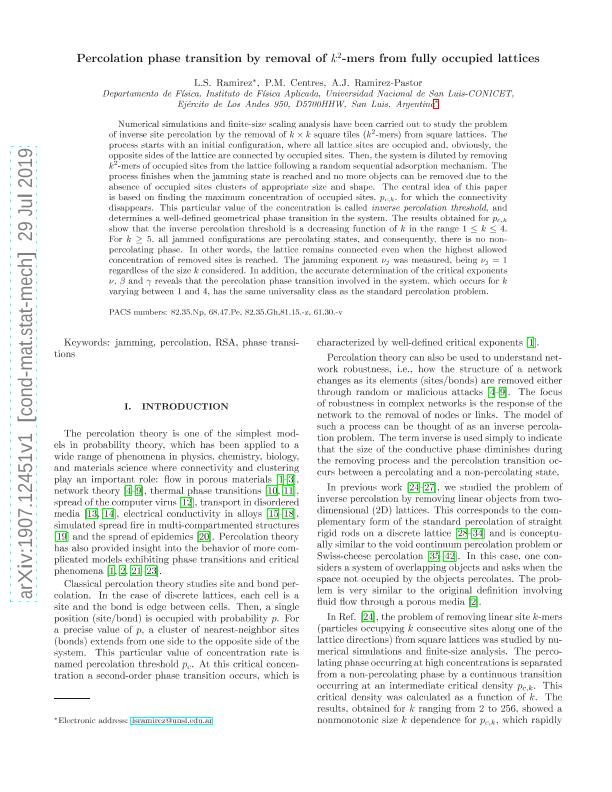Mostrar el registro sencillo del ítem
dc.contributor.author
Ramírez, Lucía Soledad

dc.contributor.author
Centres, Paulo Marcelo

dc.contributor.author
Ramirez Pastor, Antonio Jose

dc.date.available
2020-10-27T22:39:16Z
dc.date.issued
2019-09
dc.identifier.citation
Ramírez, Lucía Soledad; Centres, Paulo Marcelo; Ramirez Pastor, Antonio Jose; Percolation phase transition by removal of k2 -mers from fully occupied lattices; American Physical Society; Physical Review E; 100; 3; 9-2019; 1-12; 032105
dc.identifier.issn
2470-0045
dc.identifier.uri
http://hdl.handle.net/11336/117000
dc.description.abstract
Numerical simulations and finite-size scaling analysis have been carried out to study the problem of inverse site percolation by the removal of k×k square tiles (k2-mers) from square lattices. The process starts with an initial configuration, where all lattice sites are occupied and, obviously, the opposite sides of the lattice are connected by occupied sites. Then the system is diluted by removing k2-mers of occupied sites from the lattice following a random sequential adsorption mechanism. The process finishes when the jamming state is reached and no more objects can be removed due to the absence of occupied sites clusters of appropriate size and shape. The central idea of this paper is based on finding the maximum concentration of occupied sites, pc,k, for which the connectivity disappears. This particular value of the concentration is called the inverse percolation threshold and determines a well-defined geometrical phase transition in the system. The results obtained for pc,k show that the inverse percolation threshold is a decreasing function of k in the range 1≤k≤4. For k≥5, all jammed configurations are percolating states, and consequently, there is no nonpercolating phase. In other words, the lattice remains connected even when the highest allowed concentration of removed sites is reached. The jamming exponent νj was measured, being νj=1 regardless of the size k considered. In addition, the accurate determination of the critical exponents ν, β, and γ reveals that the percolation phase transition involved in the system, which occurs for k varying between one and four, has the same universality class as the standard percolation problem.
dc.format
application/pdf
dc.language.iso
eng
dc.publisher
American Physical Society

dc.rights
info:eu-repo/semantics/openAccess
dc.rights.uri
https://creativecommons.org/licenses/by/2.5/ar/
dc.subject
Jamming
dc.subject
Percolation
dc.subject
Phase transition
dc.subject
Monte Carlo
dc.subject.classification
Otras Ciencias Físicas

dc.subject.classification
Ciencias Físicas

dc.subject.classification
CIENCIAS NATURALES Y EXACTAS

dc.title
Percolation phase transition by removal of k2 -mers from fully occupied lattices
dc.type
info:eu-repo/semantics/article
dc.type
info:ar-repo/semantics/artículo
dc.type
info:eu-repo/semantics/publishedVersion
dc.date.updated
2020-07-22T15:41:38Z
dc.journal.volume
100
dc.journal.number
3
dc.journal.pagination
1-12; 032105
dc.journal.pais
Estados Unidos

dc.journal.ciudad
Washington DC
dc.description.fil
Fil: Ramírez, Lucía Soledad. Consejo Nacional de Investigaciones Científicas y Técnicas. Centro Científico Tecnológico Conicet - San Luis. Instituto de Física Aplicada "Dr. Jorge Andrés Zgrablich". Universidad Nacional de San Luis. Facultad de Ciencias Físico Matemáticas y Naturales. Instituto de Física Aplicada "Dr. Jorge Andrés Zgrablich"; Argentina
dc.description.fil
Fil: Centres, Paulo Marcelo. Consejo Nacional de Investigaciones Científicas y Técnicas. Centro Científico Tecnológico Conicet - San Luis. Instituto de Física Aplicada "Dr. Jorge Andrés Zgrablich". Universidad Nacional de San Luis. Facultad de Ciencias Físico Matemáticas y Naturales. Instituto de Física Aplicada "Dr. Jorge Andrés Zgrablich"; Argentina
dc.description.fil
Fil: Ramirez Pastor, Antonio Jose. Consejo Nacional de Investigaciones Científicas y Técnicas. Centro Científico Tecnológico Conicet - San Luis. Instituto de Física Aplicada "Dr. Jorge Andrés Zgrablich". Universidad Nacional de San Luis. Facultad de Ciencias Físico Matemáticas y Naturales. Instituto de Física Aplicada "Dr. Jorge Andrés Zgrablich"; Argentina
dc.journal.title
Physical Review E
dc.relation.alternativeid
info:eu-repo/semantics/altIdentifier/url/https://link.aps.org/doi/10.1103/PhysRevE.100.032105
dc.relation.alternativeid
info:eu-repo/semantics/altIdentifier/doi/http://dx.doi.org/10.1103/PhysRevE.100.032105
Archivos asociados
